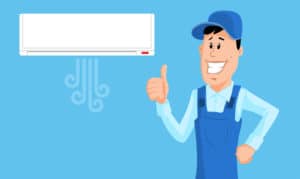All About Indoor Air Quality: Information on Your Indoor Air and How to Improve It
Air: it’s everywhere on this planet. It has to be — otherwise we wouldn’t be here at all. Vital for all living things, the Earth’s air is one of our most important natural resources. It is a mixture of mostly oxygen and trace amounts of a few other gases. Unfortunately, just like other natural resources such as food and water, air can be contaminated. This is a fact most of us know too well. Those who live in densely populated cities or inversion-prone zones most likely see smoggy skylines from their windows. Others can inhale contaminated air from commercial emissions or natural disasters such as forest fires. But contaminated air isn’t something isolated to the great outdoors. It can happen to indoor air also.
Our homes, businesses, and public buildings all circulate air that ranges in quality from excellent to poor based on a myriad of factors. This is known as indoor air quality. Indoor air quality (IAQ) refers to the air quality within and around buildings and structures, relating to the health and comfort of occupants. At its best, indoor air quality is something none of us really notice. At its poorest, indoor air quality can cause a number of problems.
In this guide, we have put together a comprehensive overview of indoor air quality — its history, causes, and related health concerns. We’ve also compiled a list of steps you can take to ensure that your indoor air quality is as pristine as possible. Many of these steps may require professional servicing, which we are proud to provide.

A History
The modern concept of indoor air quality has a history that parallels the rise of industrialization worldwide. While polluted air was thought to cause human-health problems by societies dating as far back as the ancient Greeks, it was not until the industrial revolution that the effects of air pollution became clear. The burning of coal in large cities such as London lead to exorbitant amounts of soot in the air. This contributed to widespread respiratory diseases and higher death rates. From these sobering observations, a collective consciousness about air quality began to form.
It was not until the 20th century that research on indoor air quality began in earnest. Several studies performed throughout the century found evidence suggesting that indoor air quality contributed to excessive morbidity and mortality. Studies from the early 21st century suggest that the unvented burning of biomass for cooking in developing countries is the cause of at least 2,000,000 deaths a year. In the developed world, poor indoor air quality is considered to be a primary cause of allergies, other hypersensitivity reactions, airway infections, and cancers. Excessive dampness, low ventilation rates, and plasticizers characterize poor air quality.
Today, government agencies such as the Environmental Protection Agency (EPA) have sought to improve indoor air quality through government-funded studies, awareness campaigns, and regulations. However, the problem of poor IAQ persists.
Concerns
Indoor air quality is a major concern because of its ability to affect human health. Exposure to pollutants in the air can cause health issues ranging from mild and immediate to severe and chronic. For humans, the immediate health effects of poor indoor air quality include:
- Irritation of the eyes, nose, and throat
- Headaches
- Dizziness
- Fatigue
The severity of these short-term reactions varies from person to person due to:
- A person’s age
- Preexisting conditions
- The severity of air pollution
Long-term health effects of poor IAQ include:
- Respiratory diseases
- Heart disease
- Cancer
All of these can be severely debilitating, if not fatal. The likelihood of these long-term effects manifesting is determined in large part by the extent of air pollution, the degree and duration of exposure to the pollution, and the preexisting conditions of exposed parties.
Causes of Poor Indoor Air Quality
As evidenced above, poor indoor air quality can lead to health concerns for people of all ages and demographic groups. This is because polluted air contains substances that are harmful for the human body. In this section, we examine these substances, their sources, and the many ways in which they can contaminate our indoor air.
Put simply, substances that contribute to air quality degradation are the very same substances that are harmful to ingest in any manner. These include a host of synthetic chemicals, molds, bacteria, dust, burnt material, and many other substances. These pollutants can come from a number of sources, including:
- Fuel-burning combustion appliances
- Tobacco products
- Building materials and furnishings—including asbestos insulation, newly installed flooring, carpet, or upholstery; and cabinetry or furniture made of certain pressed wood products
- Products for household cleaning and maintenance, personal care, or hobbies
- Central heating and cooling systems and humidification devices
- Excess moisture
- Outdoor sources such as radon, pesticides, and general outdoor air pollution
These pollutant sources often occur in indoor locations. These are due to inadequate cleanliness, inadequate ventilation, and owner inattentiveness in general. Thankfully, these issues can be remedied.
Improving Your Indoor Air Quality
Though poor air quality is a widespread problem that is sometimes caused by a wide range of pollutants, it can also be treated relatively easily through routine property care and maintenance. Regulating the use of harmful chemicals, and their sources, in your home or business is essential to keeping pollutants out of your air. Because moisture is the lifeblood of mold and bacteria, minimizing it will improve your IAQ. Most importantly, you’ll want to be sure that your indoor ventilation system and HVAC components are up-to-date and functioning properly. Dirty or damaged ducts and appliances can quickly pollute air—no matter how clean it may be elsewhere. While it is possible to clean and repair these components on your own, it’s advisable to hire a professional to ensure a job well done.
For Excellent Indoor Air Quality
Here at 1-800-anytyme, our team of highly-trained technicians proudly provides comprehensive air quality inspections and maintenance. With decades of experience and the industry’s latest tools and technology, we can help you optimize your IAQ in no time.
Interested in improving your indoor air quality? We would love to help out. Contact us at (760) 477-0072 to speak with a member of our team!
